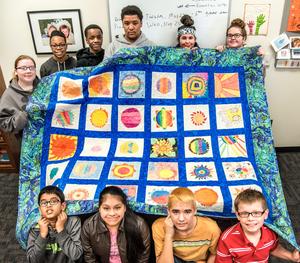Laura at SewVeryEasy has a quick and easy butterfly and floral quilt you can make from just 12 fat quarters. Mix them up or make them the same, the quilt is stunning either way.
Laura at SewVeryEasy has a quick and easy butterfly and floral quilt you can make from just 12 fat quarters. Mix them up or make them the same, the quilt is stunning either way.
G and I have been logging up the miles not only taking in the wonderful sites our country has to offer, but checking out the quilt shops along the way. More than once we have come across a shop that is shuttered...no longer offering a haven for quilters. So, when we stumbled across a shop in Flagstaff that has been in service to those who sew for three generations...well, there was no passing up that shop!
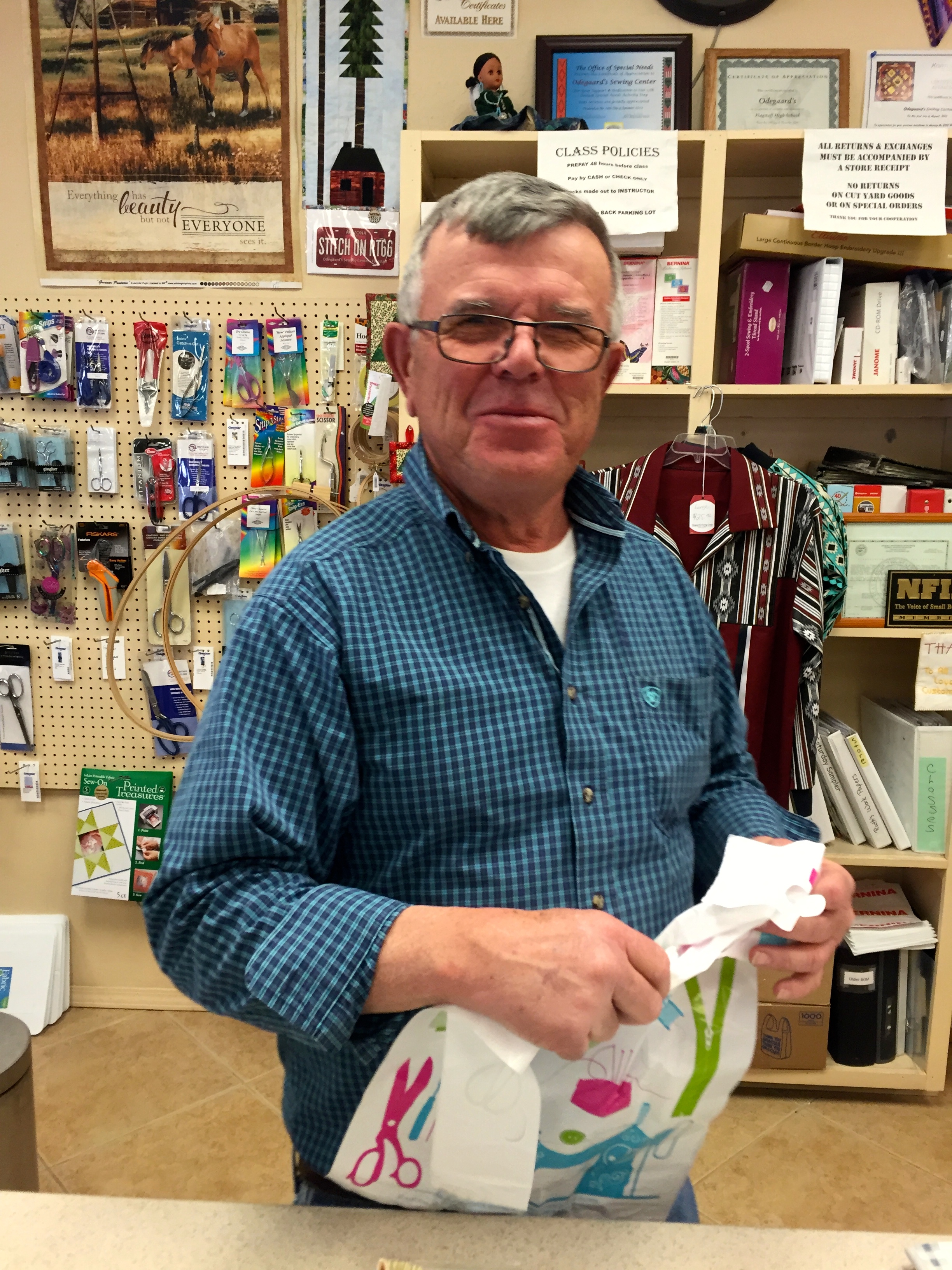
Charlie Odegaard has been the most recent generation helping quilters/stitchers in the pursuit of their craft and art. The shop was opened by his grandparents in 1970 and continues to be a place for those who need a sewing machine or something to sew in Northern Arizona...or, for those traveling through. It is huge and offers a wide variety. The Independent Quilt Shop, which we promote through the Quilt Roadies, has added another shop to the list of must visits. You will not only have a wonderful shopping experience but Charlie...well, he treats you like a long lost friend. You need something, he is going to hunt around the shop himself to find it for you. Which brings me to the chair. I wrote about my sewing chair a few months ago...how incredibly comfortable it was to sew for hours. Hitting your back in just the right place, keeping your legs in just the right flex. So much so that gals in my sewing group each have one. Remember these...not very attractive, but if it will keep me sewing for a few hours pain free it is worth every penny!

Charlie sells these chairs and will ship but...OMG...look at the new ones!!! Absolutely adorable!!! And they support you in the same way as the not so cute model does. It comes packed in a box and you'll have to put it together...but really, doesn't every sewing room need a chair like one of these? I wanted one soooo bad, but we're talking 24 feet of RV...no storage space and we are only half way through our journey. I guess I will have to mail order mine :) Contact Charlie...support a thrid generation quilt shop at http://www.odegaards.com/.
Click here to visit Anna's blog.
Click here to visit Anna's YouTube Channel.
 |

Throughout 2017 we will be pairing quilters in the USA with an International team member to participate in what we hope will be the largest international exchange of miniature quilts in history! The purpose of the project is to cross borders and cultures with quilts around the globe.
We are excited to have over 240 participants and it is growing daily. We anticipate a large need for non-USA quilters to pair with USA quilters so please share this opportunity with your non-USA quilting friends. We currently have 60 “Ladies in Waiting” who are seeking an international partner.
Here’s the basic info:
To learn all of the details, go here.
News from Argentina:
One quilter already participating is “silachas” from Argentina. With the help of Google Translate, she wrote and said, “Here in Argentina there is almost no patchwork. Actually one has to make magic to develop this fabulous art. Having communication with another quilter is the best and it seems I can touch the sky with my hands, I am so grateful. With respect to my teammate Cheril, we are already communicating and it works very well with Google Translate. Thank you for everything!”
To join the International Miniature Quilt Exchange, simply join the group here.

Want to turn that plain old t-shirt into a fabulous piece of fashion? Here's a tutorial just for you. Grab your crew neck T and about a yard of "stretchy" fabric and you'll be on your way.
Spoonflower has the tutorial and a link to the Free pattern.
Auction ends this Wednesday, April 12 at 8:00 PM CDT
This is truly a once in a lifetime opportunity to bid on quilts made by the author of Threadplay, quilt artist and innovator Libby Lehman.
Libby’s quilts have graced the walls of numerous museums, including the Smithsonian, and private collections around the world. One of her quilts, “Joy Ride,” is recognized as one of the twentieth century’s 100 best American quilts.
There will not be another opportunity to acquire one of Libby’s quilts. In April 2013, Libby, who is considered the innovator of machine embroidery, suffered a near fatal brain aneurysm followed by a stroke. While Libby has made an amazing recovery, she is no longer creating quilts as she once did.
Libby and her husband, Lester (pictured below with one of Libby's largest quilts, Frenzy) have decided to offer her remaining quilts in this online auction, which is comprised exclusively of quilts created by Libby.
Several quilts featured in Libby's book, Threadplay, are in the auction. Frenzy, Flotsam, and Tidewaters are three of her largest quilts featured in the book and in the auction.

Cindy Dampier of the Chicago Tribune has written a thought-provking article, "Uniting Politically Divided Quilters, Stitch by Stitch." In it, she talks about how quilters respond to the world around them through their quilts, whether it be political, social, or personal.
Star Members can watch Show 1103: The Skinny on Stripes in which this piece was featured.
Click here to learn how to order the book. Click the button to see what bonuses come with membership.
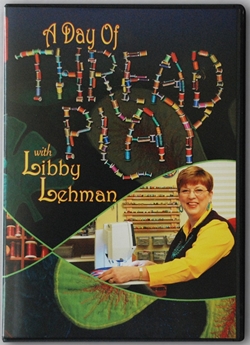
Libby is a special teacher. With humor and an amazing assortment of tricks and tips, Libby will give you techniques you can use right away on your quilts. TheQuiltShow.com has her teaching DVD online for free to Star members. Click below to learn more or click to Join or Renew and get started on this 90 minute class.
"Join Libby as she takes you on an informative and exciting adventure with thread play! From sheer ribbon illusions to potluck appliqué, after watching this DVD you'll never view thread the same way! Learn how to do free-motion embroidery with decorative threads, reverse appliqué that works especially well with pieced backgrounds and large shapes and much, much more!"
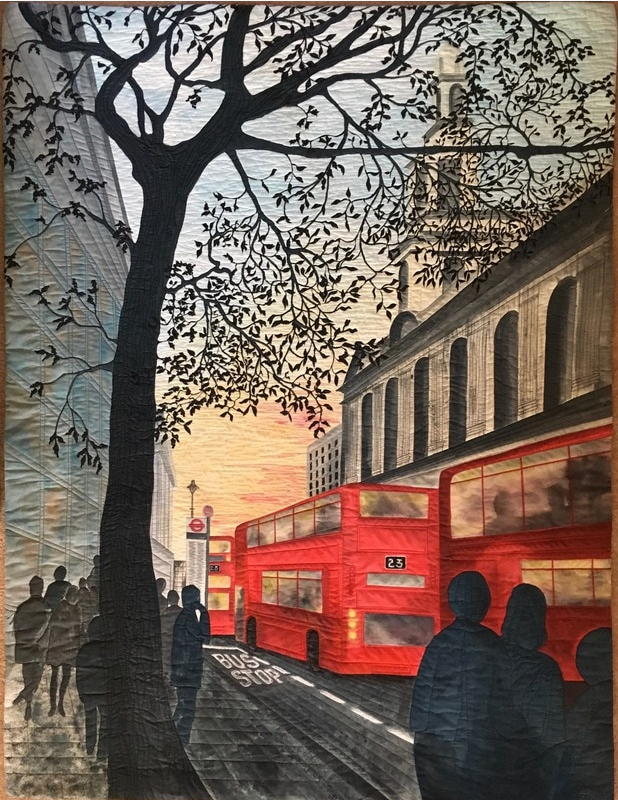
When it comes to creating the illusion of space on a flat two-dimensional surface such as a quilt, the use of imaginary (or real) lines to create perspective trick the viewer into thinking that there is actual three-dimensional depth. Subjects appear less flat when you give them perspective. Last week we shared five of the six key ways an artist can create space on a two-dimensional surface. This week we will focus on the sixth element, perspective.
Think of it this way. If it's large, it's closer. If it is small, it's further away.

Let's use the drawing of a tree lined road as an example. If you look closely, you will see a horizontal line that is not quite in the center of the drawing. This line represents the horizon. The mountains sit at the base of the horizon line, while the clouds hover above.
The road is drawn using two lines that meet at one point along the horizon line. The lines of the street are drawn at an angle to create the illusion of distance and depth. Notice how both the road, and trees along it, seem to disappear into the horizon. At the point where everything seems to disappear is called the vanishing point.
Now look at the trees along the road. In real life, the trees would all be the same size. But, in a drawing, the trees along the road need to be smaller to give the impression that they are further away.
In two-point perspective there are two vanishing points. Think of standing at the intersection of a city road. 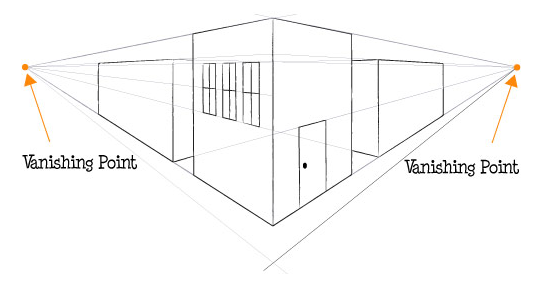
The building closest to you is the largest, while those on either side seem to vanish in two different directions.
Now that you have seen the graphic illustrations, let's look at examples in actual quilts:
One-Point Perspective
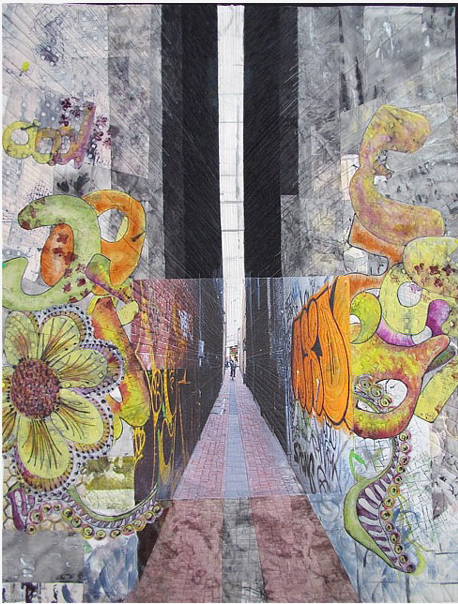
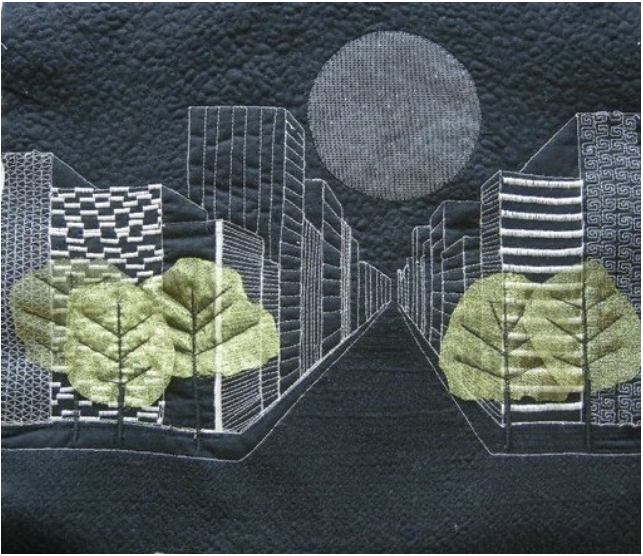
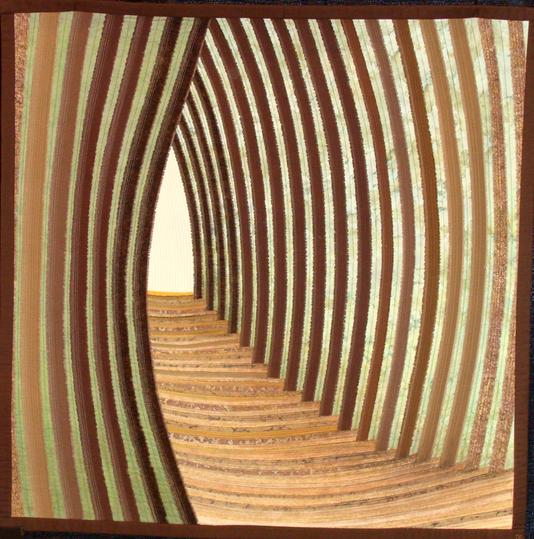
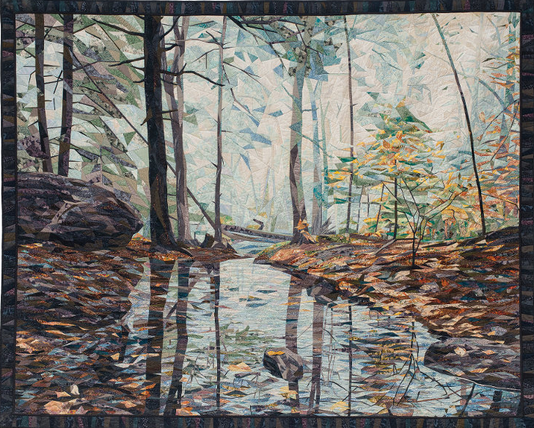
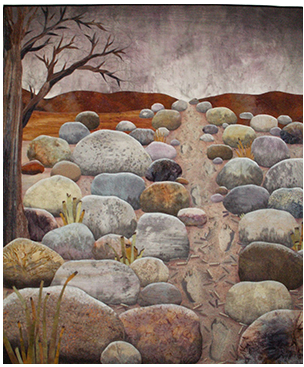
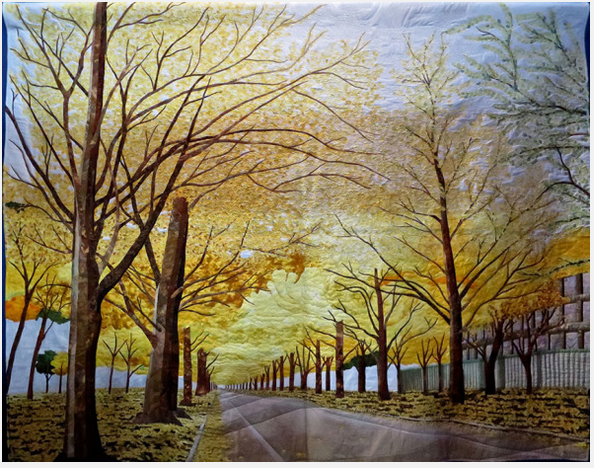
Two-Point Perspective
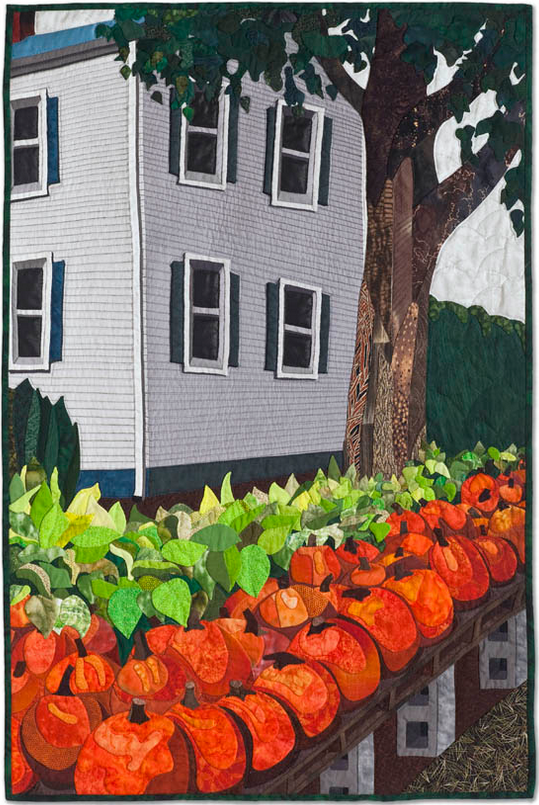
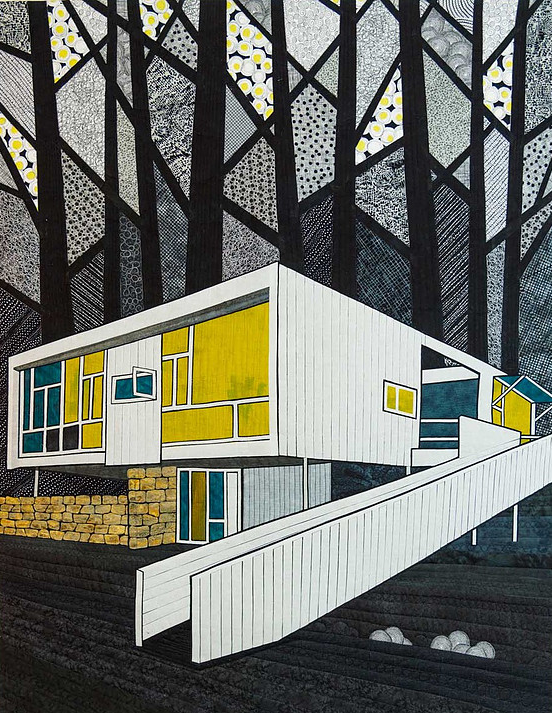
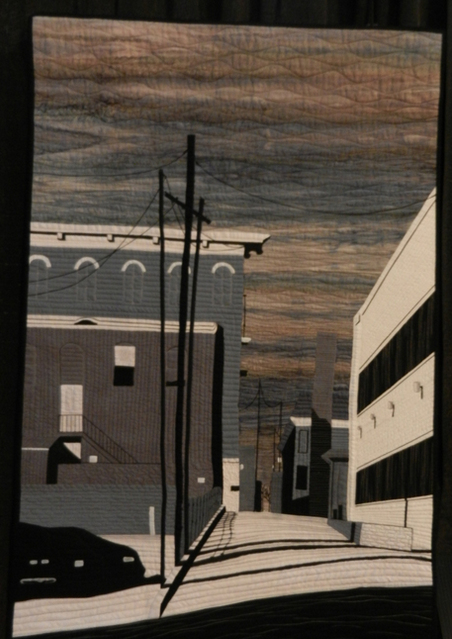
by Allie Aller (Show 1906)
Landscape quilts that employ the basic concepts of perspective have richness and believability. We are drawn into the scene to our visual delight.
What is perspective? It can be defined as the rendering of three dimensional space on a two dimensional page (or in our case, the flat surface of a quilt.)
What are the basic concepts of perspective and how can we use them?
The first is depth. We want to see into a landscape. To "fool the eye" into perceiving elements in our landscape as being nearer to us or farther away, thus providing depth, there are some basic tricks we can employ.
In the examples below, four tricks are used:
1) Objects in the foreground are heavier and more detailed. The orange autumn tree closest to us has thicker lines than the yellow trees in the middle ground. The hills in the background are made with thinner and thinner lines. This simple trick gives the illusion of distance.
2) Faraway objects get paler in color. In this first quilt, the hills in the background become a paler and paler purple, the farther away they are.

3) The same objects, farther away, are smaller. In the Lake Michigan scene below, the trees to the right of the picture, which are farther away, are rendered as shorter, but we "know" they are really the same size as the trees in the foreground. This concept is called "diminution".
4) The foreground shows lots of detail and texture; the farther into the background we go, we see less detail. Notice in this second picture that there is a lot of grassy detail in the foreground; then there is less in the middle ground, and none at all in the background.
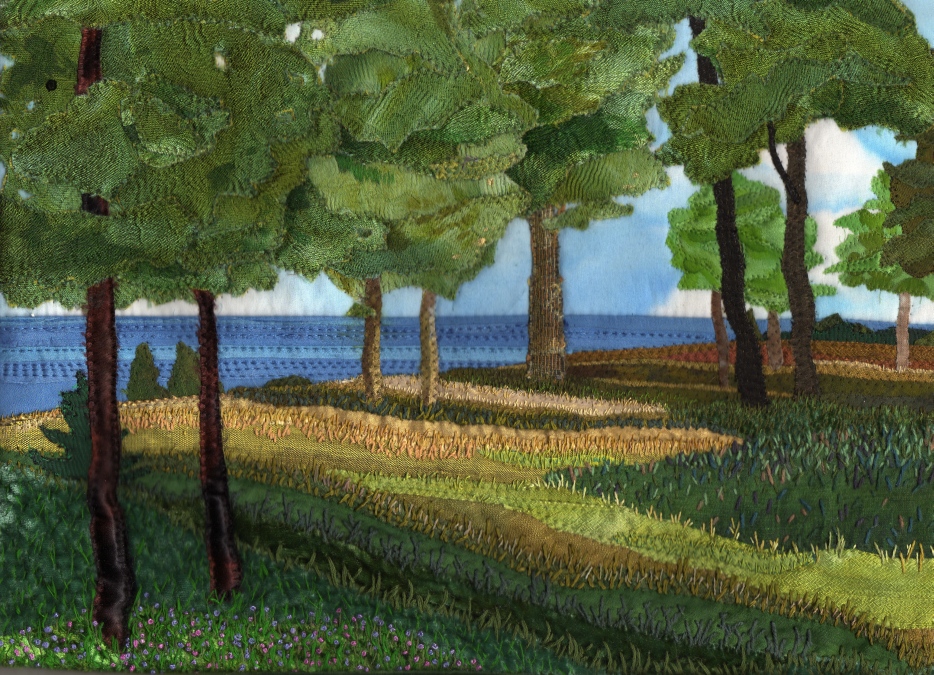
The second basic concept of perspective is convergence. Vertical lines that are parallel in real life appear to get smaller and closer together as they recede into the background. That is because they are all aimed at the vanishing point, that imaginary point at which parallel lines receding from an observer seem to converge in the distance to a common point on the eye level or horizon line. (More on the Horizon Line in a moment.)
In the two pieces below, the fence lines illustrate this concept. In reality those fence posts are all the same size and spaced equally apart, but in perspective, they get smaller and closer together, the farther into the background they recede. This doesn't have to be perfectly accurate, just believable.

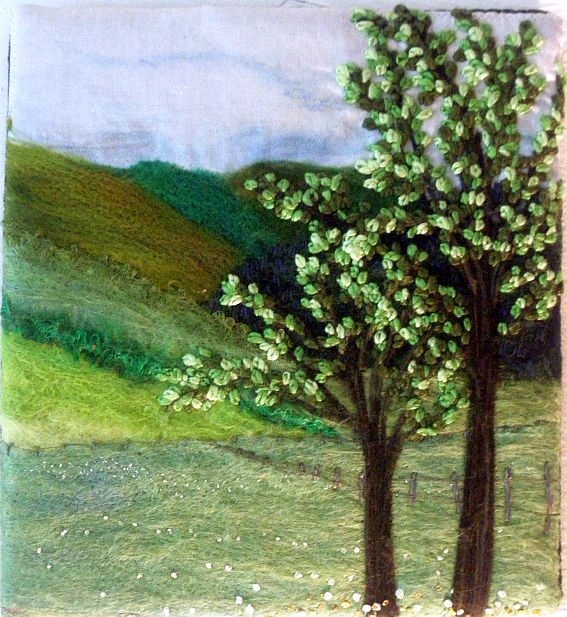
Besides the fence posts suggesting perspective, in this second felted and embroidered piece, even the little French knot flowers are larger and farther apart in the foreground, and tinier and closer together in the background. Both these tricks work together to create the illusion of depth.
The little house in the quilt detail below also just hints at perspective, the way the roof line and ground line, though parallel in real life, convey two converging lines, aimed toward the vanishing point on the horizon.

This leads us to the third basic concept in perspective, the horizon line. It is the actual height of the viewer’s eyes when looking at an object, interior scene, or an exterior scene. That eye level height determines how the viewer will see the scene.
From an aerial view, or bird's eye view, we are looking down on a scene, and the horizon line is very low. The eye level view shows an image or scene just as we would look straight out at it from a standing position, so the horizon line will be somewhere in the middle of the picture. From the worm's eye view we are looking up at our scene, so the horizon line will be very high.
So if we have an eye level view and are looking directly at a house, it will look like this, as in this embroidered printed photograph:
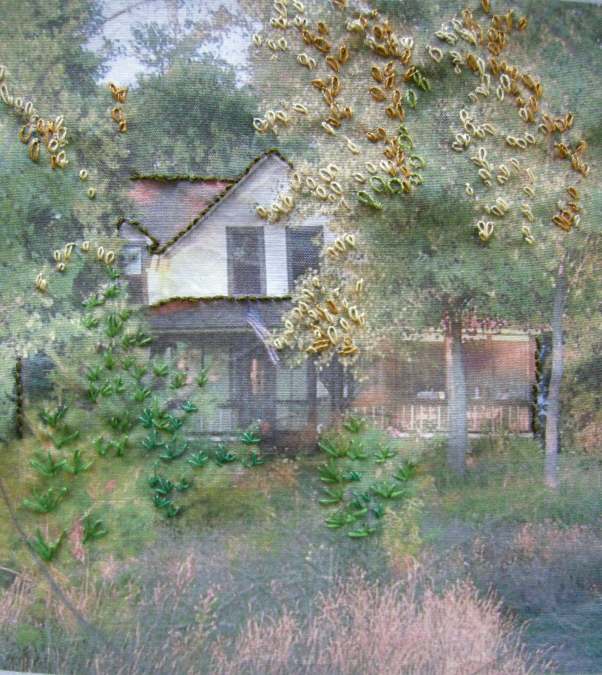
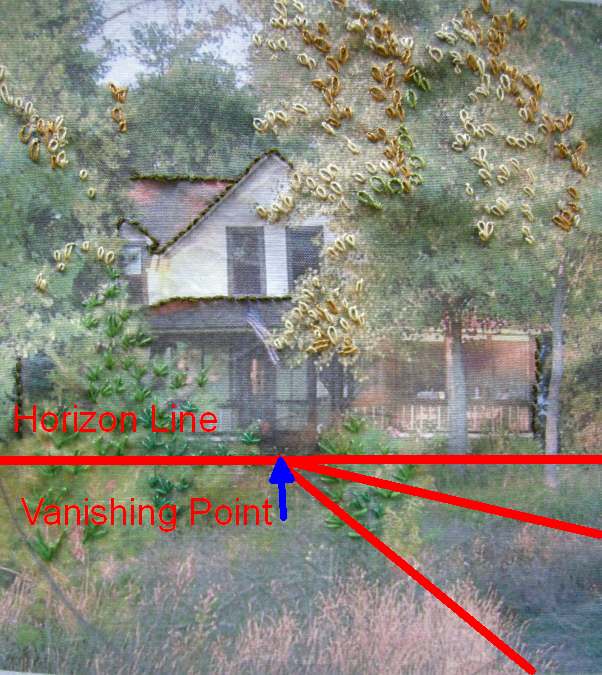
The horizon line, though we don't see it, is right about level with the steps of the porch, with its vanishing point right under the door. But look! Notice the shadow in grass in the lower left corner. That is actually a trodden path leading to the front door, and can you see how its lines converge towards the vanishing point? Even this subtle convergence gives depth and perspective to our scene.
Let's review these two basic rules for using perspective in quilting to gain depth in a scene:
1) Make the objects in your foreground with bigger heavier lines, more detailed shapes, and richer in color and texture than objects in the background. (This is why I always make my landscape skies very, very flat. I personally don't want texture in my sky because it brings it too much to the foreground, and really, what could be further away than the sky?)
2) Determine which view you want to show your quilt's picture from: aerial, eye level, or worm's eye. That will help you find your horizon line and vanishing point, where all lines in your scene converge.
Homework:
Look at several photographs of buildings or simple scenes, and determine where the horizon line and vanishing point is in each one. See how lines in the image--roof lines, window casements, etc, angle towards that vanishing point.
Then as you go about your day, occasionally frame a scene with your hands and try and determine the horizon line and vanishing point in the view you are seeing. The series of photos below are an example of an aerial view with a low horizon line, looking down my driveway.
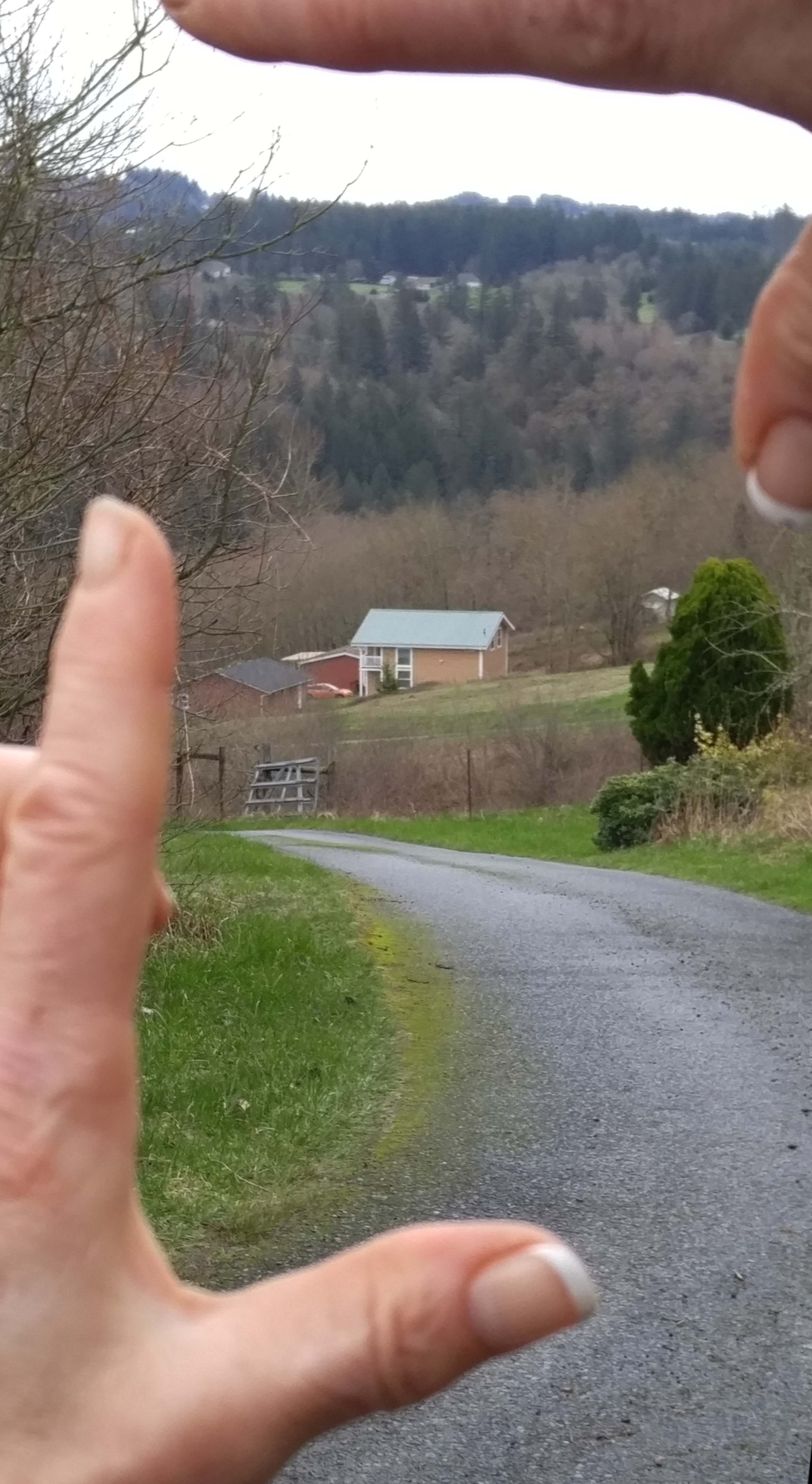
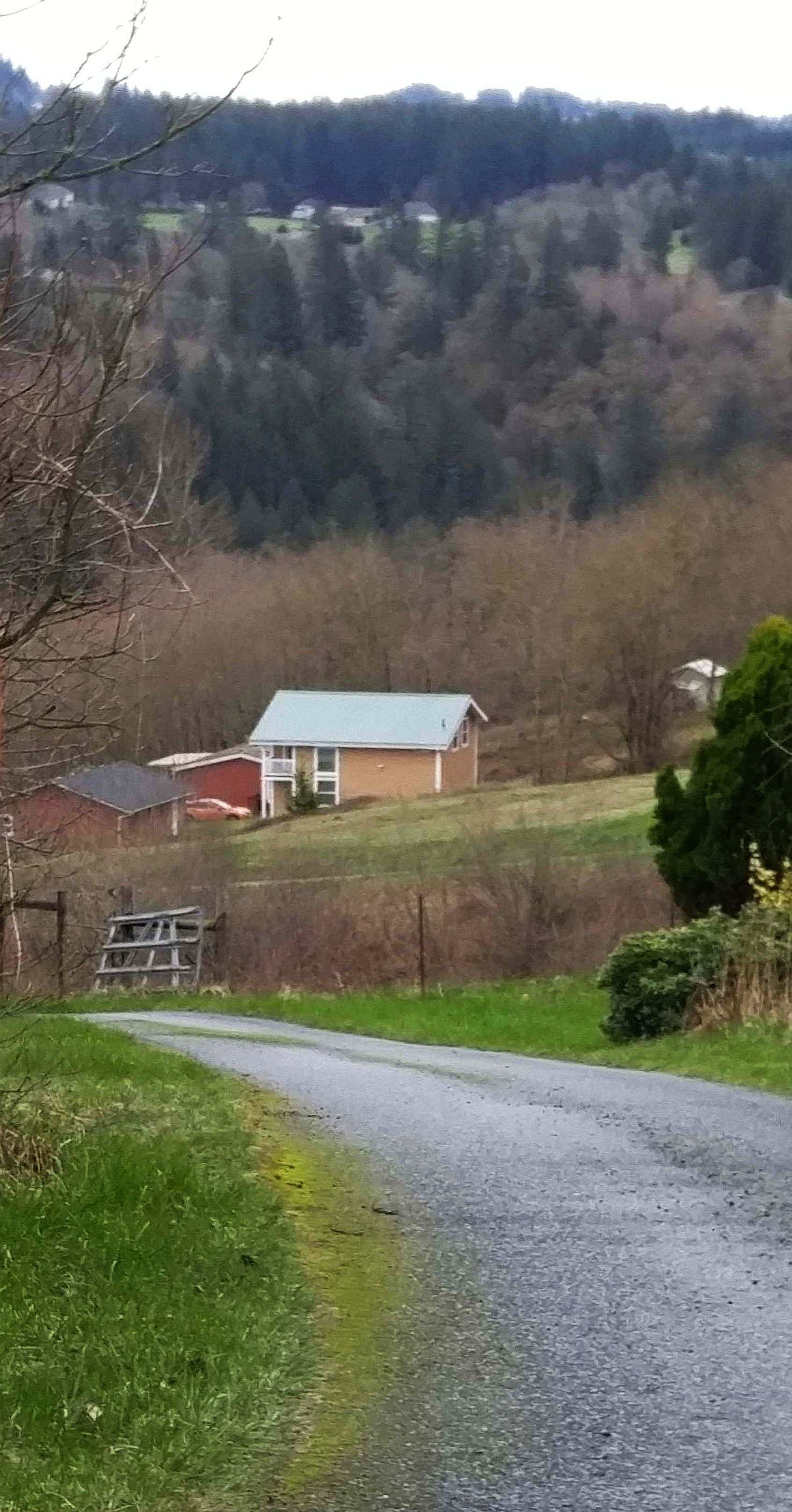
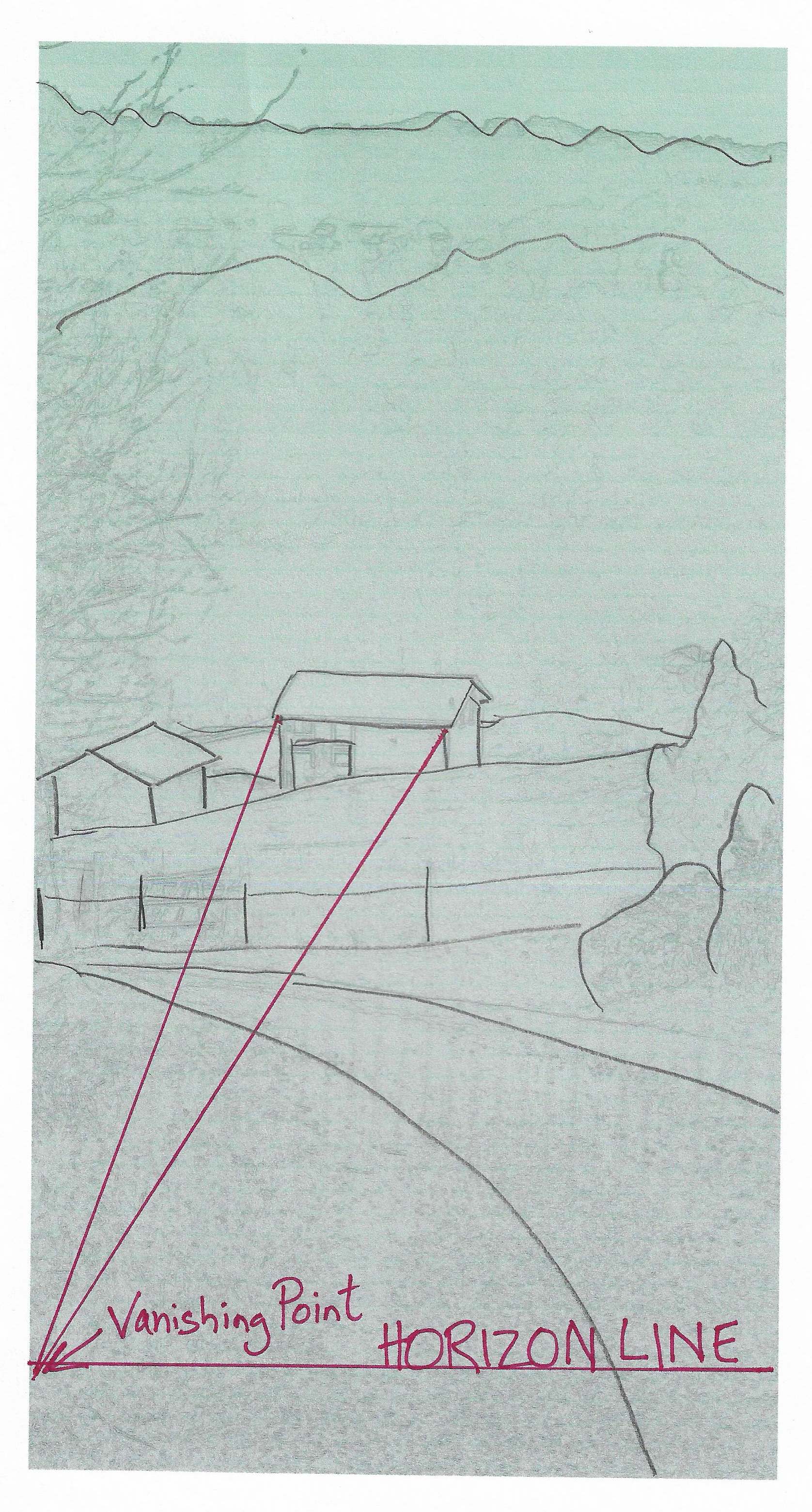
If you start thinking and seeing this way, it will come out in the quilts you make as well.
Copyright 2017 All quilts by Allie Aller
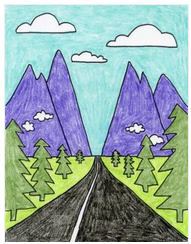
by Kathy Barbro
Here’s a simple landscape tutorial that illustrates how to draw perspective with a vanishing point. The drawings help show how much space can be implied in your art just by paying attention to lines and scale. And by keeping elements like the trees all the same type, it’s easy to see how they get smaller and smaller, the further away they get from you.
MATERIALS
• Drawing paper
• Fine tipped black marker such as Sharpie
• Crayons or colored pencils
View and download the landscape tutorial here.
DIRECTIONS
1. Lightly draw a center guideline on the drawing paper with a pencil.
2. Follow the Landscape Tutorial for drawing the landscape.
3. Trace the drawing with a black marker.
4. Color the landscape with crayons. Try using dramatic colors, as in a black road and colored mountains.
Click here for more topics related to the Design to Quilt program.
